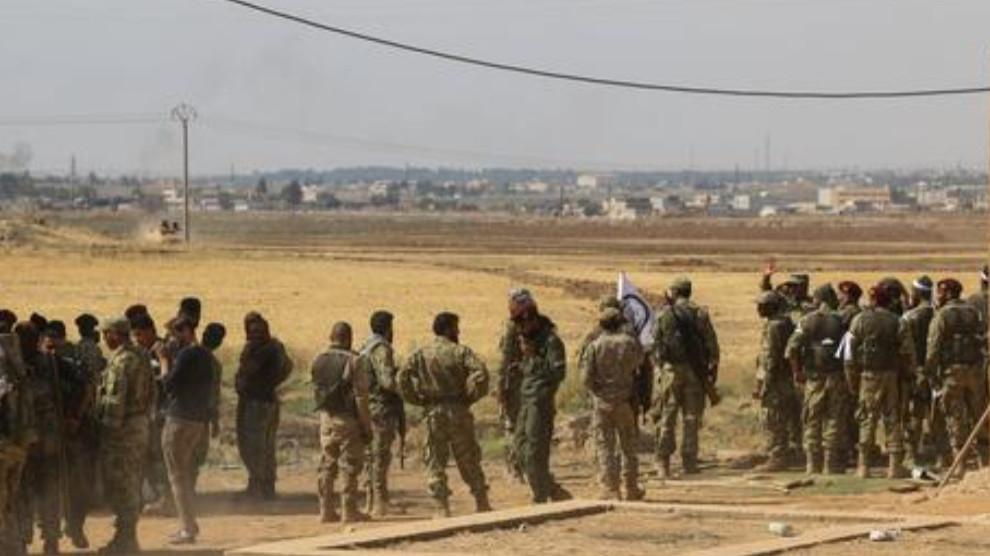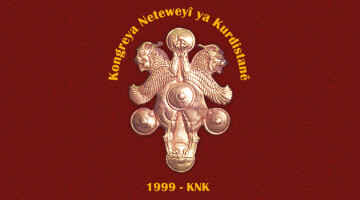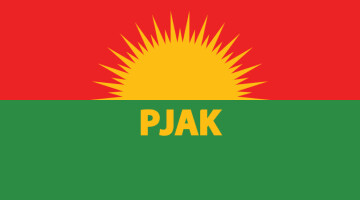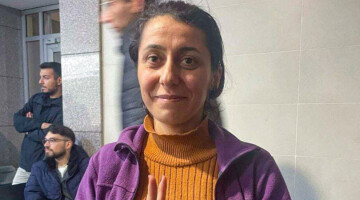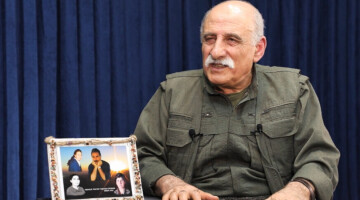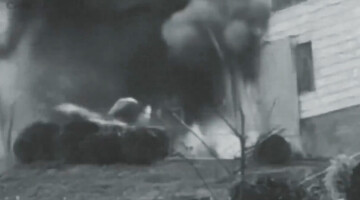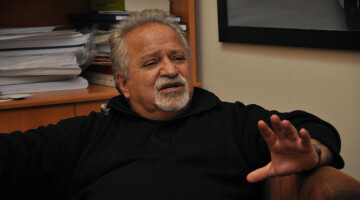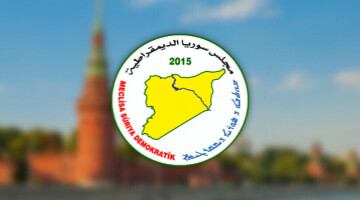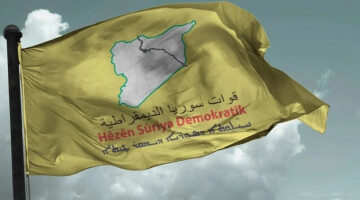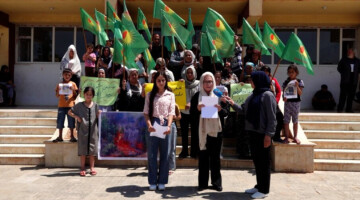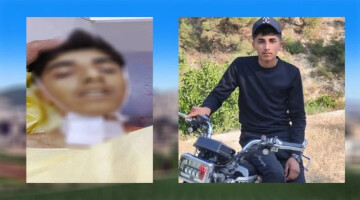The Turkish state is using different groups to occupy Syria. They all go under the name of "Syrian National Army-SMO (Ceyşul Wetenî)" and each has a separate agenda although in the end they all serve one agenda, Turkey's.
The Turkish state has one plan, which is to dekurdify Northern and Eastern Syria and ultimately to invade the region, such it did with Iskenderun Livası (Hatay) and sell it to the international community.
The Turkish state uses dozens of different groups, many of them originating from Al Qaeda and the Muslim Brotherhood to occupy Syria.
The Turkish state placed in strategic places on the border line the groups which claimed to be composed of "Turkmens", such as Sultan Murad, Sultan Suleyman Shah, Sultan Mehmed Fatih, Muntasir Billallah and Samarkand. While it puts the groups composed of Arabs on the front line to fight against the Kurds.
The idea of the Turkish state is to create a sort of "Turkmen belt" on the border with Northern Syria.
Worst case scenario: The Adana Agreement
After the Adana Agreement reached on 20 October 1998 between the Turkish state and the Syrian regime, Turkish intelligence began to invest in these groups and is now trying to legitimize the occupation by placing these groups on the 5 km line along the border line.
The Turkish state, knowing that it will not be permanent in Syria, places elements of these 5 groups in the regions in order to implement the "5-kilometer hot line" article on the border line.
The Turkish state keeps these 5 groups behind in order not to suffer losses in the conflicts. While these strategic groups have under their control important places such as as border gates and road routes, other groups, mostly composed of Arabs and foreigners, are leading inward.
After the occupation of Afrin the mercenaries of other groups competing with Sultan Murad had been clashing with one another.
Now along the border of Syria there are groups composed of "Turkmen": the majority being from Uzbekistan, Turkmenistan, Turkmenistan, Tajikistan, the Uighurs composed of mercenaries brought from the Caucasus and Central Asia.
These groups were located in Idlib, Cebel Ekrad (Kurdish mountain), Cebel Turkman (Turkmen mountain) Bab El Hewa Border Crossing, Entarib, Cindirêsê, Raco, Bilbilê and Şera districts in Afrin, Bab Al Selame Border Gate in Ezaz.
Now the Turkish state has deployed them on the border lines of the region and started to settle these groups along the first 5 kilometers of the border and in Girê Spî and Serêkaniyê.
There are 29 groups under the name of Syrian National Army working for Erdogan.
1- Ehrar El Şerqiye: This group broke off from ISIS in Deir Ez-Zor and moved to Idlib. It came to the fore for its brutality, plundering, theft and rape.
2- Ceyş El Nuxbe: Formerly Ceyş El Tahrir announced in 2017 that they reorganized under the name Ceyş El Nuxbe. This group led by Mihemed Ehmed El Seyêd operated in Aleppo, Latakia, Hama and Idlib. Together with Nusra they killed Kurds in Til Eran and Til Hasil. They took part in the occupation of Afrin.
3- Liva Suqur Al Sham: This group, which was founded by Ehmed Abu Isa in 2011, worked with Al Nusra for a long time, and later joined Ehrar Al Sham. Known for its jihadist ideas, contains a large number of foreign mercenaries. They took part in the occupation of Afrin.
4- Feylaq El Damascus: Established in 2014 with the participation of 19 groups. This group, headed by Fadil Elah El Heci, took part in the attacks against Şehba and Şêx Meqsûd. This group, which is also in the occupation of Afrin, has good relations with the Turkish state and is one of the largest structures within the SMO.
5- Ehrar al-Sham: This group, one of the largest, was founded in 2011 by Hesen Ebod. The group, which operates in many places in western Syria, had a fluctuating relationship with Al-Nusra. They're working together in Idlib right now. They joined the invasion of Afrin.
6- Hamza Division: This group, which was previously active mainly in Dera, Aleppo and Damascus countryside, started to operate mainly in Bab when relations with the Turkish state developed. Led by former ISIS member Seyf Ebubekir, has good relations with the Republic of Turkey and took part in the occupation of Afrin.
7- Liwa El Fatah: This group, which had previously worked with different groups, announced that it had joined the al-Shamiya in 2017.
8- Jaysh al-Ahfad: One of the first groups to form the National Army Bloc. Together with Liwa Samarkand, they were initially part of the Firqet El Hemze. This group, led by Şêx Husen Geud, took part in the occupation of Afrin.
9- 23rd Division: Formerly active in Aleppo and Idlib, where we found it under the name of Sertip Hesen Recûb. They took part in the Euphrates Shield and the occupation of Afrin.
10- 9thDivision: This group, which was organized as special forces in 2014, was part of the Hezim movement supported by the Pentagon. When this structure, which was in favor of the Islamic idea, carried out some actions against Al Nusra, they were liquidated by Al Nusra, and the Turkish state reorganized them. They joined the occupation of Afrin from the south of the city.
11- Foc El Mustefa: Eli Necar Abu Mejdo is the leader of this group based in Marê which is known for its proximity to the Turkish state. This group, known for its statements against the Kurds and the SDF, was found in Afrin, especially on the Bilbilê line.
12- Liva El Mexavir: In 2013, this group, which operates in Homs and Damascus countryside, withdrew to Idlib after an agreement with the regime and took part in the occupation of Afrin.
13- Firqet Al Mutasim: This group, based in Marê, received arms and training support from the United States and was led by Mihemed Xelil Hesen. They took part in the occupation of Afrin.
14- Front Al-Shamiya: This group was established in 2014 and was headed by Ebid el Eziz Selamê. When Asifet El Shimal joined them in 2017, Abu El Sico took part in the direction. They took part in the occupation of Afrin.
15- 5th Regiment: Also known as Foc El Xamês is led by Mistefa Kepso. This group operates in northern Hama and Idlib and joined the occupation of Afrin.
16- Liva Al Shimal: It was created by Feylaq Al Sham by bringing together groups such as El Fecir El Sadêq, Sirac al Din, Ansar al Allah, Omar Abu al Hesen and Mexawir al Sunne. This gang group operating in Manbij, Jarablus and Shehba region took part in the occupation of Afrin.
17- Rical El Harb: It is a group that operates around Aleppo and Idlib.
18- Liwa Sultan Osman: Founded in 2017 by Raxêb Osman, nicknamed Abu Omar, this group was located in the vicinity of Bilbilê in Afrin.
19- Jaysh Al Islam: Established in 2011 in Eastern Guta, was one of the largest groups. The commander of this structure, known for its Salafi ideas, was Zehran Elûş. This Saudi-backed group used chlorine gas in the Shêx Meqsûd attacks. After Zehran Eluş was killed, his brother Mihemed Eluş took his place. This group joined the Riyadh and Astana meetings, and after leaving Guta settled together with Feylaq Al Rahman in Bab and Afrin.
20- Festakim Kema Umirt: Istanbul was the place where it was founded in 2012 with the participation of 7 groups. Mistef Biron (Seq is Abu Quteyb) is the leader. The group has developed many partnerships, and is supported by Turkey, Qatar and the Saudis.
21- Jaysh al-Sharqiyah: It is one of the small groups and is members are from the eastern regions of Syria.
22- Suwar al-Jazeera: Shah Ahmad and Abu Zeyneb al-Hashimi are the leaders of this group, which emerged with the aim of fighting against the Kurds in the Cizîrê region. This Jarablus-based group took part in the attacks on Manbij and the occupation of Afrin.
23- 51st Brigade: Heysem Cemil İfesi was the head of the group that was established in 2015. When he took part in the National Army, the group leader became Mihemed Dêrî. They attended the meetings in Geneva and took part in the occupation of Afrin.
24- Firka al Shimaliya: Liwa Fursan El Heq was the first name of this group which was founded in 2012 in the town of Kefer Nubul, in Idlib. The CIA-backed group was headed by Faris al-Beyoush, but in 2017 Ebid Kerim Yehya took his place. He was also killed in Şêx Meqsûd.
25- Sultan Murad: The establishment of this group, to unite Turkmens when the Syrian war started, dates back to 1998 after the Adana Agreement. Group leader, Yusuf El Selêh's relationship with MIT goes as far as the Adana Agreement. Fehim Isa was in charge of the field and Serb Ehmed Osman was in charge of the military. It is the group on which the Turkish state invests the most. Control of borders and borders gates are left to this group.
26- Sultan Suleyman Shah: This group, which was composed of Turkmens in Bab region, tried to form some Kurdish groups in Qibesin region. However, it did not succeed. This group, headed by Abu Emse, took part in the occupation of Afrin.
27- Sultan Mehmed Fatih: This group was established by the Turkish state in the town of Xendura in Jarablus in 2012 and stayed in Aleppo for a long time. They joined Sultan Murad in 2015 and left in 2016. They mainly occupy Jarablus, El Rai and Ezaz and took part in the occupation of Afrin.
28- Muntasır Billallah: This group, which was previously located in Aleppo, operates mostly in Bab, Al Raî and Jarablus. This group is led by Firas Basha, works directly under the Turkish intelligence and took part in the occupation of Afrin.
29- Samarkand Brigade: Founded in Aleppo countryside in 2016, this group is supported by the Turkish state. It consists of people brought from Central Asia, especially Uzbeks. They explained the reasons for their establishment as fighting against the Kurds and the regime and took part in the occupation of Afrin.

